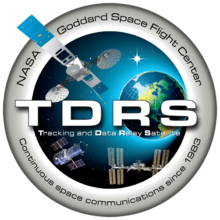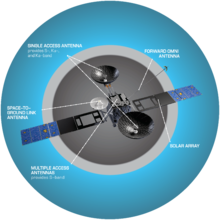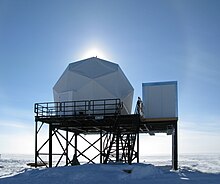Tracking and Data Relay Satellite System
The Tracking and Data Relay Satellite System ( TDRSS ) ( English for Kursverfolgungs- and Data Relay Satellite System), a network of US communications satellites and base stations, which by the NASA is used for space communications. The system was designed to replace the existing network of ground stations that had supported all of NASA's manned missions until then. The main goal of the development was to increase communication coverage and bandwidth. The first Tracking and Data Relay Satellites (TDRS) were brought into geostationary orbit in the 1980s with the help of the space shuttle . Other TDRS were put into operation by Atlas II and Atlas V. The currently last satellite TDRS-M was launched on August 18, 2017.
History of origin
To meet the requirements of highly available communication between space objects and earth stations, NASA founded the Spacecraft Tracking and Data Acquisition Network (STADAN) in 1961. The use of parabolic antennas and communication equipment in South and North America enabled orbit coverage of 15% to be achieved. In the 1960s, additional stations were added in Europe, Asia and Australia; the network grew to 20 stations.
At the end of the Apollo Soyuz test project in 1975, NASA decided to merge the Manned Space Flight Network (MSFN) and STADAN in the Spacecraft Tracking and Data Network (STDN). After the consolidation to STDN, the disadvantages of globally distributed base stations in geopolitically unstable countries became apparent. A new space-based communication system should be developed. The new system should be based on geo-orbital satellites, which can transmit and receive data based on their position within sight of base stations.
It was assumed that there were two base stations - on the west and east coasts of the USA - two operational satellites and one reserve satellite. In 1983 the first TDR satellite (TDRS-1) went into service, and in September 1988 TDRS-3 launched, forming the first Tracking and Data Relay Satellite System. After the study was completed, it was recognized that adjustments were still necessary to achieve 100% earth coverage. A small area was not covered by the use of only two ground stations and was therefore out of sight. This area is also known as the Zone of Exclusion (ZOE). As a result, no communication could take place between the spacecraft and the ground station in this area. The problem was solved by adding an additional satellite in 1991, a ground station in 1992 and switching to a configuration with three operational satellites. A 100% coverage was established. This later became the basis for the TDRSS network design used today.
network
The structure of the TDRSS is similar to that of other space systems such as the European Data Relay Satellite . It consists of three main components:
- Base station
- Space segment
- User segment
In order not to endanger space missions in the event of a fault, these components are redundant.
Base stations and remote stations
The base segment of TDRSS consists of two base stations, the White Sands Complex (WSC) in southern New Mexico and the Network Control Center Goddard Space Flight Center in Greenbelt, Maryland. These two base stations form the core of the network and provide command and control services. WSC, near Las Cruces , consists of:
- White Sands Ground Terminal (WSGT)
- Second TDRSS Ground Terminal (STGT)
- Extended TDRS Ground Terminal (ETGT)
There are also two remote stations, the Guam Remote Station (GRS) and the Blossom Point Remote Station (BPRS). The tasks of the WSC also include remote control of GRS and BPRS.
The selection and location of the locations had to meet a number of criteria. They had to be in the field of view of the satellites, near the equator, and have favorable weather conditions with few rainy days, as is the case in New Mexico. WSGT was commissioned in 1978, just before the scheduled launch of the space shuttle in 1979. STGT has been operating since 1994, following the successful launch of TDRS-6.
WSGT and STGT operate independently of each other, but have an emergency fiber optic cable to secure data in an emergency. Each of the two stations are equipped with 19-meter dishes - also known as Space-Ground Link Terminals (SGLT) - to communicate with the satellites. Three SGLTs are installed on the WSGT and two on the STGT. In order to guarantee full satellite coverage, a SGLT was installed and put into operation in Guam in 1992. The GRS at N 13.6148 ° E 144.8565 ° is an extension of the WSGT system. The base station has six SGLTs, with the WSGT in the TDRS Operations Control Center (TOCC) being responsible. Before commissioning, NASA used an alternate station in Diego Garcia to ensure full satellite support.
Space segment
The space segments of the TDDRS are designed as a dynamic system. New orbiting satellites use three as primary satellites; the rest can be switched on immediately as a reserve as the primary satellite. The original TDRSS design had two main satellites, named TDE (East) and TDW (West), and a replacement satellite. The increase in data in the 1980s prompted NASA to expand the network with additional satellites.
User segment
The user segment of the TDRSS is a central component in many NASA programs. Programs such as the Hubble Space Telescope and LANDSAT transmit their observations to the operations center using TDRSS. The advancement of manned space travel was one of the reasons for the development of TDRSS, and the technology is also used in the space shuttle and in the ISS as a communication transmission.
Units of the STDN
The main components of the Space Flight Tracking and Data Network (STDN) are the NASA Integrated Services Network (NISN), the Network control center (NCC), the Mission operations center (MOC), the Spacecraft data processing facility (SDPF) and the Multi mission flight dynamics lab (MMFD).
NISN provides data transmission lines for space missions and operates a wide area network and telecommunication lines for transmission of data, voice and video services for all NASA companies and programs. The NISN infrastructure consists of network cables, computers for network flow control in fiber optic cables and various network components. Two protocols are used: the Internet Protocol Operational Network (IPONET) and the High Data Rate System (HDRS). IPONET uses the TCP / IP protocol, which is also common on the Internet , to transfer data. HDRS is used for missions that require a high data transfer rate. The throughput rate is between 2 and 48 Mbit / s. HDRS does not require a network infrastructure such as routers, switches and gateways to transmit data.
The NCC is responsible for the planning, reliability and control of services. It processes user requests and transmits the information to the responsible bodies. The control and security unit supports real-time applications in receiving, validating, displaying and transmitting TDRSS performance data. The NCC was located in the Goddard Space-flight Center in Greenbelt, Maryland until 2000 and was then moved to the WSC.
The MOC is the central point of missile control. It administrates support requests, monitors missile performance and controls the information to the missiles via TDRSS. Researchers, general planners, mission planners and flight control are based in the MOC. The mission planners provide documentation for missiles and missions. The flight operators are responsible for direct communication with the missile by issuing commands and performing operations.
The MMFD Lab provides flight project support and network tracking as well as altitude and orbital measurement control. The orbital parameters are determined by comparing the current orbital data of the spaceship and the planned data. The setting parameters are determined by a set of parameters, such as the orientation of the missile in relation to known objects such as the sun, moon, stars or the earth's magnetic field. The tracking network analyzes and evaluates the quality of the tracking data.
Operations
TDRSS has been used for data transmission in many space missions and is also used for data connection to the Antarctic McMurdo station , which can be reached via the TDRSS South Pole Relay Station. The American part of the international space station ISS also uses TDRSS for data exchange.
production
The first seven TDRSS satellites were built by TRW (now part of Northrop Grumman Aerospace Systems) of Redondo Beach , California, and the following ones by Hughes Space and Communications , Inc. of El Segundo , California (now part of Boeing ).
Movie
The TDRSS was featured in the James Bond film Moonraker and in the film Event Horizon .
Start sequence
During the production phase, all TDRSS satellites are labeled alphabetically in ascending order. When a satellite reaches the geostationary orbit intended for it, this identifier is converted into a numeric one. For this reason, satellites that have been completed but have never been put into operation due to launch incidents or malfunctions are not identified numerically, but instead keep their alphabetical identifier (TDRS-B was never numbered because of the accident with the Challenger space shuttle , for example ).
See also
Web links
- NASA's Goddard Space Flight Center Space Network Official Page
- NASA's TDRSS program overview page
- NASA's Goddard Space Flight Center TDRS K / L Project Official Page
- History of TDRSS NASA Official Page
literature
- D. Baker (Ed.): Jane's Space Directory: 2001-2002. Alexandria, Virginia: Jane's Information Group, 2001.
- Consolidated Space Operations Contract (CSOC): Certification & Training Course 880 & 882: TDRSS Orientation & System Data Flow. 2000.
- C. Kraft: Flight: My Life in Mission Control. Plume Books, New York 2002.
- G. Kranz: Failure is not an option. Plume Books, New York 2000.
- NASA .: 2nd TDRSS Workshop: Jun 25-26, 1996. 1996. Retrieved from the Internet on Aug 25, 2003.
- NASA Spacelink: News Release May 13, 1993. 1993. Retrieved from the Internet on Aug 25, 2003.
- NASA .: Guam Remote Ground Terminal. Retrieved from the Internet on Aug 25, 2003.
- J. Sellers: Understanding Space: An Introduction to Astronautics. McGraw-Hill Companies, New York 2000.
- T. Thompson: TRW Space Log. TRW Space & Electronics Group, Redondo Beach, California 1996.
- J. Wertz, W. Larson: Space Mission Analysis and Design. 3. Edition. Microcosm Press, Torrance, California 1999.
Individual evidence
- ↑ Raumfahrer.net Editor: NASA relay satellite TDRS M in space . Retrieved September 5, 2017 .
- ^ Three Generations of Tracking and Data Relay Satellite (TDRS) Spacecraft. In: NASA. June 9, 2016, accessed December 13, 2018 .



